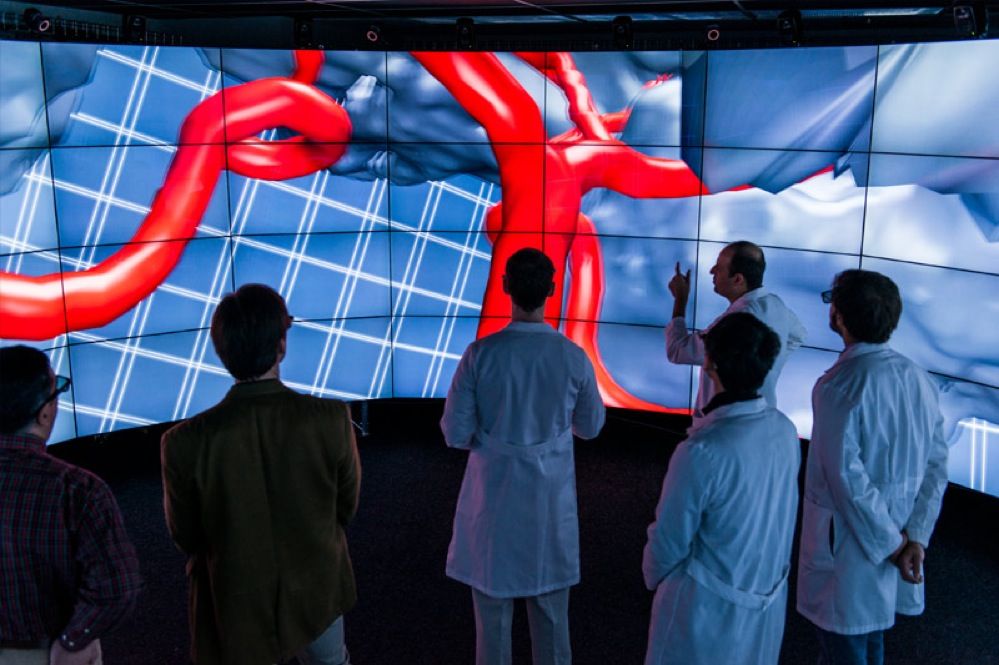More than ever before the health industry is incorporating technology into healing and promoting health. Heart surgery is one of the many fields in which virtual reality is being used to improve outcomes.
Surgeons at OSF Saint Francis Medical Center in central Illinois are using a room-sized model of the human heart that makes it possible to walk through the chambers and see inside this vital organ. It might seem like a video game, but it’s actually a powerful tool that can help surgeons find solutions to complex health issues and create better outcomes for heart health patients.
Dr. Mark Plunkett, a pediatric heart surgeon, recalls his first experience with the virtual reality heart, “I was blow away. The virtual reality technology has taken what was already a wonderful advancement and moved it to a whole other level.” Dr. Plunkett described his experience with the HTC Vive Virtual Reality system as impressive and can still recall how he felt look at the anatomy of his actual patient’s congenital heart complex, an exact replica of the anatomy.

VR Improves on 3D Imaging
The heart health industry has made amazing advancements in the last several years. It began with 3D printed images of patients’ hearts. Just a few short months later, engineers and clinicians at the Jump Trading and Simulation Center were able to create the VR heart models.
3D imaging, as impressive as it is, is not enough. The diagnostic dilemma faced by surgeons treating congenital cardiac anomalies is visualizing the complexity of the heart using 2D tools. The complicated connections within the heart make it challenging to diagnose problems and create appropriate treatment plans. It’s also difficult to reconstruct accurate 3D models from 2D images but this was the best method and what was being used to make critical surgical decisions until recently.
)
3D printed models improved on the status quo, but still aren’t perfect. In 3D immersive virtual reality technology, surgeons gain a deeper understanding and visualization of cardiac models, without the expense and time-consuming nature of 3D printed models.
According to Dr. Bramlet, head of the Advanced Imaging and Modeling Department at Jump, the goal of his team is to “…put tools in the hands of physicians that they didn’t realize they needed… This tool (3D VR) that I believe can improve the understanding that a clinician has over that specific patient… is an invaluable tool.” Dr. Bramlet also points out the VR heart model is more efficient, and cuts down on the time and cost it takes to print a 3D heart.
According to Dr. Plunkett, “I was able to enlarge the heart to a size that I was able to sort of step inside the heart looking at the hole in the heart that I was going to be patching surgically.”
VR Tools Already Making Impact
Dr. Matthew Bramlet describes how tools such as this one transform medical imaging. The VR technology has already been used for 55 patients at the hospital, three of which were Dr. Plunkett’s patients.
Dr. Plunkett explains how the virtual heart has helped him by taking the guesswork out of his work. He continues, “There won’t be any surprises because we know exactly what we’re going to find when we get in there because these images are that patient’s anatomy.”

The VR-based visualization of the heart shows a great deal of promise and doctors and researchers hope it deepens understanding of patient-specific anatomy. They believe it has the potential to become an important diagnostic resource in the future.
Dr. Bramlet and Jump don’t plan to stop at the VR heart. Their goal is to expand the program beyond cardiac medicine, and perfect the technology for neurologists and radiologists. They also hope the VR tech can be used in medical school, making it easier for medical students to learn.





